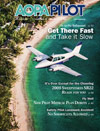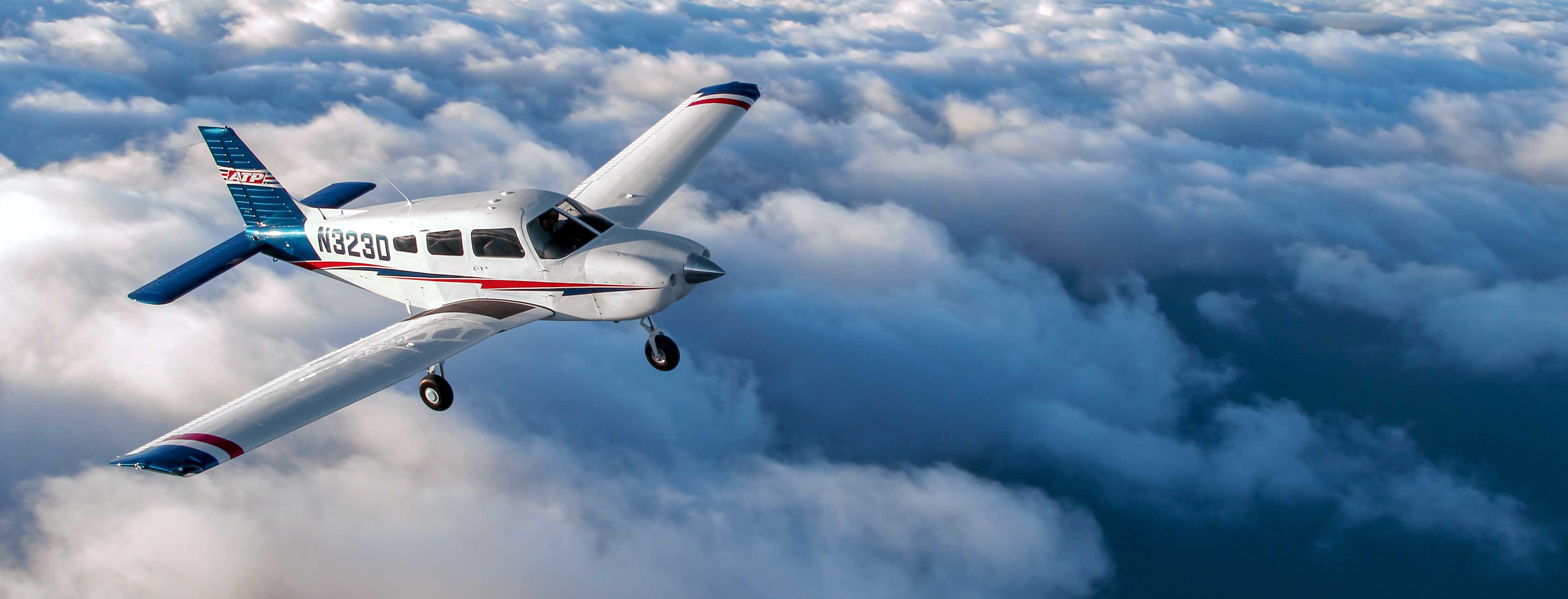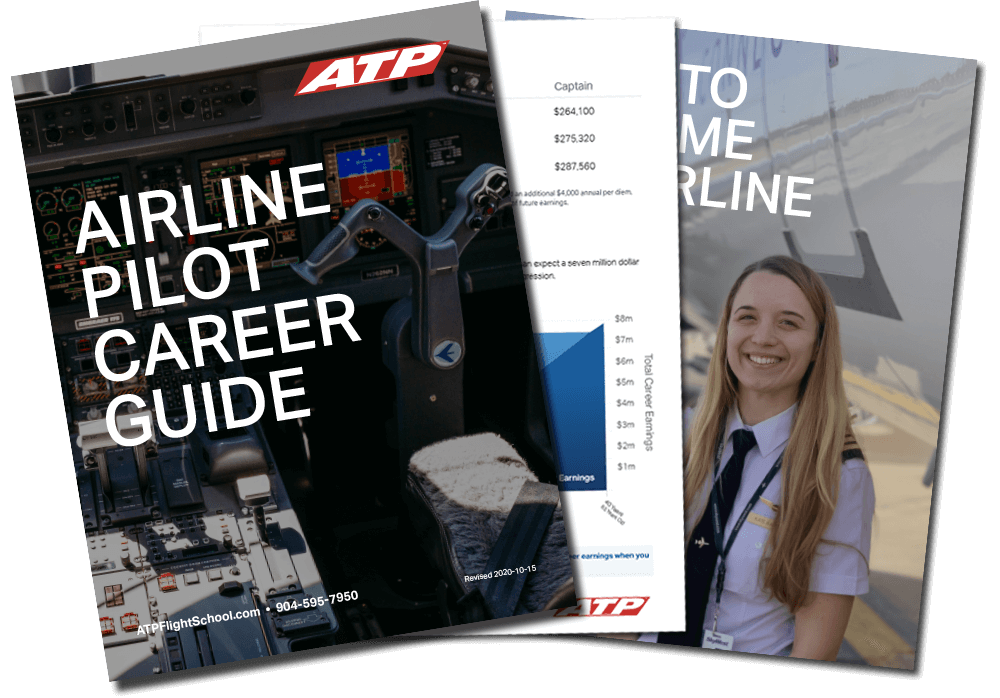The Accidental Aviator
Holding short of the active runway, Erika Thompson calls for the Before Takeoff checklist in a level, professional voice. As the pilot flying, she sits in the left seat of the white-and-blue Piper Seminole. Her flight partner—the pilot not flying—responds by reading the checklist items for Thompson's action and acknowledgement. "Before Takeoff checklist complete," he concludes.
After clearing for traffic, Thompson taxies onto Runway 12 at Marana Regional Airport in Tucson, Arizona; lines up with the centerline; and smoothly applies full power to the two Lycoming O-360s. At 8:20a.m. the density altitude at the airport, elevation 2,031 feet msl, is already 4,200 feet. The Seminole is quickly airborne and headed back to Phoenix on the return leg of a cross-country trip to build pilot-in-command flight time for Thompson, a student in the Airline Transport Professionals (ATP) Airline Career Pilot Program.
Making plans
Thompson, 30, of El Paso, Texas, never set out to become a pilot. Her first airline job was actually as a flight attendant—and even that was accidental.
She was in her last semester as a psychology major at California University of Pennsylvania, eating with her parents at a TGI Fridays, when they asked her what she planned to do after graduation. Thompson told them she wanted to enroll in graduate school. “They asked me, ‘How will you pay for it?’” she recalls. “I said, ‘Oh, I’ll be a flight attendant.’ It just popped into my head at that moment. I’d only flown a few times in my life.” Growing up, family vacations usually were by car.
But Thompson had been attending a martial arts class with a woman who was a flight attendant for US Airways, and their conversations gave her some insights into the lifestyle and travel that would be required. “Travel always appealed to me. I don’t mind living out of a suitcase,” she adds.
Thompson sent applications to several airlines. Comair called first, and she trained in June and July 2003. After she’d been working on the line about three months, however, something happened. “I really liked life on the line, but I wanted to know what was going on up front.”
On one flight, the captain offered to take Thompson for an introductory flight lesson in a Cessna 172. She took him up on the offer, and soon was flying straight and level, turning, climbing, and descending. “He said, ‘Hey, you’ve got the hang of this!’ ” she recalls.
Thompson found a flight school in Cincinnati, earned her private pilot certificate in December 2004, and was working on her instrument rating when the school closed abruptly. “The school closed down on me in April 2005,” she explains. “Fortunately, I didn’t lose too much money.”
Meanwhile, things had slowed at Comair, and Thompson was relegated to a schedule on reserves. Wanting to continue her flight training, she took a voluntary furlough and finished the instrument rating at another school in Ohio. “I tried to take out money for my commercial [certificate] and the bank’s, like, ‘You’re done.’ ”
Perseverance
But the sky still beckoned, so Thompson took a flight attendant job at United Airlines®. She found it appealing because the carrier was merging its domestic and international reserve lines, and new flight attendants could get lots of interesting international experience–which she did. “I was extremely lucky but I wasn’t happy, because I wanted to finish my ratings,” she recalls.
She met her husband, Robert, when both were training at United. “He was only a flight attendant for four months–and he was spending all his international flight breaks in the cockpit, learning new stuff,” she says.
Also determined to fly professionally, her husband researched flight schools and his findings all pointed to Airline Transport Professionals. In September 2007 he entered ATP’s Airline Career Pilot Program in Phoenix; from February through July 2008, he worked as a flight instructor for ATP in Phoenix; and then he was hired by ATI Jet in El Paso where he flies charters in Learjets.
Thompson left United to be with her husband in Texas, but the nagging desire to complete her flight training remained. “It was just killing me, every time I took a break from my flight training.” In May 2009, she started ATP’s career pilot program in Phoenix.
Back to school
Thompson decided to repeat her private pilot and instrument training at ATP, because she had not been exercising those skills and because she questioned the quality of the training she received from a school that had been misappropriating student deposits. “I was rusty and wanted to start over with a school that had a good reputation,” she says. “It was a really good refresher.”
Amanda Case was Thompson’s flight instructor for her multiengine private and instrument ratings. “One of her best assets is that she always wants to learn,” Case recalls. “I had to go home at night and study, to be able to keep teaching her new things.” Some students only want to learn what’s needed to progress. “It’s refreshing to teach somebody who just wants to learn more. That will be a huge asset for her going forward.”
Thompson says her first solo flight was her most memorable training experience. “That was the most amazing day of my life.” Later, on an IFR cross-country from Akron, Ohio, to Erie, Pennsylvania, “We were in the clouds most of the time. We broke out at minimums and there was the runway. That was awesome–you don’t get a lot of that in Phoenix.”
But she did get a lot of cross-country experience at ATP. “That was a big reason I decided to come here. The cross-countries and crew procedures are what set ATP apart,” Thompson says. “It builds your confidence–definitely.”
ATP’s Airline Career Pilot Program offers several options, and all include nationwide cross-country pilot in command flying, explains Dave Tatone, chief pilot at ATP’s Phoenix location. Students can begin with a private pilot certificate, or enroll with zero flight time. For those who complete ATP’s private pilot single-engine program, which includes 85 flight hours, the checkride is normally targeted at 55 hours; the remaining 30 hours are flown cross-country for instrument-rating preparation. “We get them used to the IFR structure–filing and picking up clearances,” he says.
All of the career pilot program flying is in ATP’s fleet of 83 Seminoles; simulators play a key role as well. “Thirty-five days after they’ve started the career program, they’re multiengine- and instrument-rated,” Tatone says. Before students are released to fly cross-country, paired with another student, they take an evaluation flight in the Seminole with an instructor.
The student calls ATP’s dispatcher and is assigned a destination and a flight partner.
The crew plans the flight and preflights the airplane. “The dispatcher reviews the weather and reviews their flight plan,” he says. “You might do three legs in a day.” The dispatcher books hotel rooms and students are reimbursed for taxis; food is the only out-of-pocket expense.
Students log 50 hours of multiengine PIC time over two weeks. “Then they come back and start prepping for the commercial multiengine checkride.” That’s followed by the commercial single-engine checkride, then CFI training. There’s a lot of homework to complete, as well. “It’s not going to be handed to you,” Tatone says. “You’ve got to self-prepare if you’re going to succeed in professional aviation.”
Flying to Florida
During her cross-country flying Thompson got to fly east to Florida. “We got all the way to Fort Lauderdale,” she recalls, with stops in El Paso and San Angelo, Texas; Monroe, Louisiana; and Pensacola, Tampa, and Jacksonville, Florida.X “Then we came back a little different way. We got to stop in Meridian, Mississippi, as well. Definitely places I hadn’t been before.”
She values the experience of flying to so many different airports, as well as different weather. “We don’t get that much weather in Phoenix,” she notes, adding that bad weather in Phoenix usually means a no-go, but in Florida, “you usually can pick your way through it. We got some actual [instrument] time. That was a first for my flight partner, flying in actual clouds.”
Minimum en route altitudes of 10,000 feet or 12,000 feet are common in the Southwest, but in Florida, they were able to fly at 5,000 feet or 6,000 feet. “We did get to do a lot of visual approaches. We took advantage of them, because they’re more realistic.”
Thompson and her flight partner made use of Flight Watch and worked with ATC to avoid weather. They also worked with ATP’s dispatch center, located in Jacksonville. “We weren’t comfortable with the weather, and they said, ‘Call us back in an hour.’ ”
That trip, and her cross-country time-building, provided lots of experience she says she wouldn’t have had otherwise. “It definitely enhances your teamwork and your confidence as far as [crew resource management] goes.”
The Future
Because few airlines are currently hiring, most graduates are seeking jobs as flight instructors, or pursuing corporate or charter flying jobs. “Back in the heyday, nearly everybody was going right into the regionals,” said Derrick Dennis, president of ATP.
Increased hiring will return to the cyclical airline business. “We stay in touch with the hiring folks,” Dennis said. In 2007, when the FAA increased the mandatory pilot retirement age from 60 to 65, it delayed the inevitable–a peak of airline pilot retirements. As that approaches the major airlines will hire captains from the regional carriers, opening up a lot of pilot slots at the regionals. “We know the demand is coming,” he said.
“Our military is just not putting out the pilots that it once did, and the Age 65 rule is going to come to a head,” he explained. General aviation pilot starts are down, financing can be almost impossible to get, and many furloughed airline pilots will not be coming back, he added. “I think it’s going to be a more serious situation than anyone imagines.”
Even with the current downturn in training, students at the 25-year-old school–which operates 26 training centers–are earning more than 3,000 pilot certificates per year. “A lot of it is multi-engine ratings,” Dennis said, and flight instructors who have been building time are obtaining ATPs to be ready for the next hiring wave. In the past six months, ATP students have flown into more than 300 different airports across the country; the school’s aircraft burn about 150,000 gallons of fuel per month.
Soon, ATP will be able to offer extensive turbine experience to its career students. The company has ordered 20 Diamond D-JETs and has been selected by Diamond Aircraft to provide factory-authorized initial and recurrent training in the single-engine, five-seat personal jet. ATP will establish D-JET training centers in Jacksonville, Dallas, Phoenix, Atlanta, and Daytona Beach; flight training devices already are on order for each facility.
“We think it’s going to be a very desirable part of our career pilot training,” Dennis said, explaining that pilots who train in the D-JET can build flight time as mentor pilots for individual owners. “That’s what we’re really excited about,” he said. “It’s going to make the airplane very accessible, and it’s going to be a great experience-builder for our career-minded pilots.”
Erika Thompson won’t have to wait for D-JET deliveries to begin building turbine experience, however. After she completed her training at ATP, she accepted an offer from ATI Jet in El Paso, Texas, where she is qualifying to fly Learjets as a first officer.



